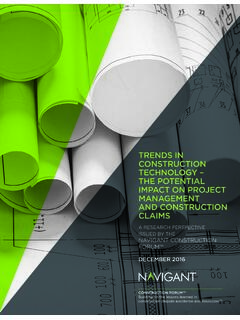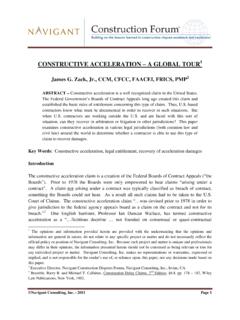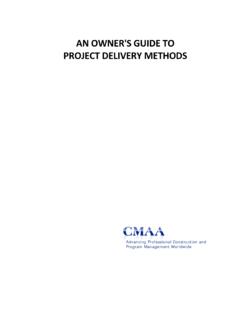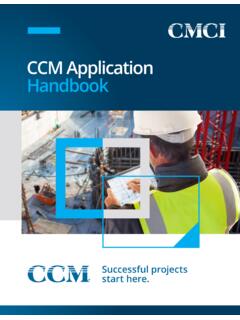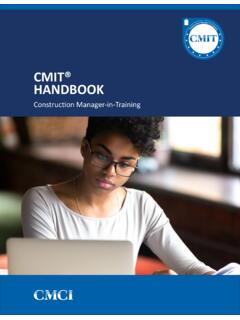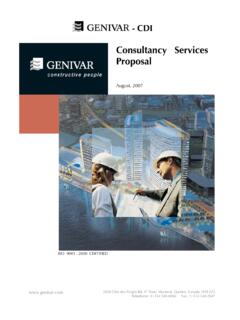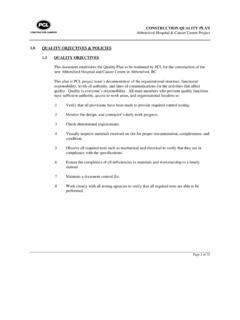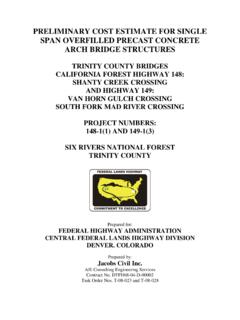Transcription of CONSTRUCTABILITY REVIEWS — AN INTRODUCTION …
1 1 CONSTRUCTABILITY REVIEWS AN INTRODUCTION Stephen R. Pettee, PE, CCM Overview Construction Managers want jobs to be successful. One strategy for a successful job is to begin with a clear and complete set of bid documents. An important step to having a complete set of bid documents is to have them thoroughly vetted by a third party and then corrected before they are advertised for bid. Experienced Construction Managers (CMs) and seasoned inspectors can help with the vetting process by reviewing documents to determine if there are built-in problems, flaws that may impede construction or factors that may cause impacts to any stakeholder in terms of time, cost or quality. One of the many services Construction Management firms can offer clients during the design phase is to provide detailed REVIEWS of draft construction plans and specifications.
2 The review is commonly known in the industry as a CONSTRUCTABILITY There are many definitions2 of CONSTRUCTABILITY REVIEWS , some of which are so complex they form narratives. But, to put it succinctly, a CONSTRUCTABILITY review (hereinafter CR) can be defined as: An independent and structured review of construction bid documents by construction professionals to make certain that the work requirements are clear, the documents are coordinated, and that they assist the contractor in bidding, construction and project administration to result in reduced impacts to the project. A CR corrects documents from the viewpoint of the contractor, the inspector and the CM. If the contractor is able to complete the project without seeking many clarifications, if the project progresses smoothly and there are few disputes, then the CR has met its goal from the contractor s perspective.
3 If the inspector knows where all building requirements can be found, how quality is to be evaluated, and how to measure payment for work elements, then the CR has met its goal from this perspective. And, if the CM is able to keep administrative efforts on budget, if changes and disputes are kept to a minimum, and if all parties can deliver a quality project to the client, then the CR has met its goal from a management perspective. The construction documents to be reviewed include draft plans, draft technical specifications and the proposed bid schedule. Depending on time allotted for the review and the direction from the client, the reviewer may also include Special Provisions, the invitation to bid, appendices and reference documents, although the latter three would be unusual.
4 To sum up the why, when and who for CRs: first, a CR is an effort to correct conflicts and clarify requirements; second, CRs are done before issuing the documents for bidding; and third, a CR must be done independently of the designer. 1 Spelled CONSTRUCTABILITY with an a, not CONSTRUCTABILITY with an i, although both word forms are used. The latter form seems to be used more in the mathematical and philosophy fields. Merriam-Webster Inc. finds the former the more common of the two spelling variants overall. Both spellings were entered for the first printing of the Collegiate Dictionary Eleventh Edition of 2003 based on several decades of word use.
5 2 Another definition is from the ASCE s Construction Industry Institute optimum use of construction knowledge and experience in planning, design, procurement, and field operations to achieve overall project objectives. This and other definitions cast too wide a net for this author. 2 There are many things a CR is not. A CR is neither a peer review3, Value Engineering4 nor a bidability5 review . However, a CR can and should overlap with a bidability review in one important way. That is, the bid schedule must be checked against the plans and specs for proper bid item breakdown, appropriate choices of lump sum versus unit price items, and accurate bid descriptions. Bid item quantities will not be checked in the CR, or will the organization of the bid schedule.
6 A CR is not a review to address construction safety, project life cycle, sustainability or an analysis for eventual demolition. The designer and owner have already made those decisions and, theoretically, incorporated them into the work scope long before the documents are available for review . A CR is not an effort to QC the documents, as that should have already been done by the time documents are issued for review . However, if there is a quality control issue, all parties are encouraged to address it in the review . See Appendix I for some examples of QC comments. The evolution of CRs in the building industry is for others to write about. However, it can be said that the need for CRs has gained acceptance by owners over the past decades.
7 It is, or should be, a routine part of the design process. The CR cycles should be included as activities in the master schedule. While most construction management firms offer this service, a few consulting firms offer CR as their sole service. Not much is published about the CR process. The literature that is published focuses more on the requirements for CR programs, case studies, performance, tools and surveys of individuals doing CRs. Most papers, proceedings and articles focus on the CR concept and implementing REVIEWS in organizations. Moreover, those papers generally relate to building construction and state transportation work. One can assume that little has been written on how to carry out a CR because most firms offer this service in competition with others and do not want to share their approach.
8 What follows will provide an exception. This paper will not teach you how to find and make comments to plans and specs. That would be impossible for many reasons, although a few reasons are worth noting. The main reason is that the types of construction projects vary greatly ( , schools as opposed to dams), and each is unique, requiring a one-time design. Consider a ten-foot steel bridge design compared to a 200-foot steel bridge design where the connections, deflections and traffic loading would be immensely different. Other reasons include: differing needs of owners, regional building standards, materials used in different parts of the country, and environmental issues ( cold weather concrete).
9 Despite these exceptions, this paper provides an INTRODUCTION to a traditional, yet formal, CR process for those who are unfamiliar with CRs. This paper explains the general approach to performing a review . This paper is written from the perspective of a third party CM for a standalone project, although the process will work for large construction programs where multiple primes are needed or the smallest work element addressed by a single change order. While it is written from the traditional design-bid- 3 A peer review is an independent review of plans and specs by an outside design firm who looks for local building code compliance, adherence to standards of design practice and design criteria, eliminating design and service conflicts.
10 Examples include use of proper design loads, non-compatibility of materials, soil problems and corrosion attack. 4 Value Engineering (VE) has a different set of goals. VE focuses more on function and performance, , project scoping, locating, optimizing processes, energy use, expandability, features, etc. VE is normally done at the 20 percent design stage. CMAA University CM4144, April 7, 2005. 5 Bidability has many definitions. The Long Beach City College 2009 Bond Management Team defines it well as, The degree to which a set of bid documents could be reasonably expected to permit a bidder to establish a competitive price to perform the Work as defined in the bid documents. More to the point, a bidability focuses on whether the bid schedule reflects the work scope, if quantities can be determined from the drawings and if contractors can prepare competent bids at reasonable cost.
